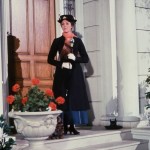Walt Disney’s daughters fell in love with the Mary Poppins books and made him promise to make a film based on them. He first attempted to purchase the film rights from author P.L. Travers as early as 1938. However, she didn’t believe any film could do justice to her books. For more than two decades, Disney tried to convince Travers to allow him to make a Poppins film. He finally succeeded in 1961.
The screenplay by Bill Walsh and Don DaGradi is primarily based on the first novel in the Mary Poppins series, with songs by Robert and Richard Sherman, who suggested the setting be changed from the 1930s to the Edwardian era of the 1910s. Pre-production took about two years, with Travers as adviser. She was very protective of her work and fought the addition of animation and the mellowing of Mary Poppins’ character. She also thought the soundtrack should feature Edwardian songs, not new ones. Disney overruled her on most counts. Travers had script approval, but Disney had final approval.
Julie Andrews won the title role (her film debut) soon after she lost the role of Eliza Doolittle (a role she created on Broadway) to Audrey Hepburn in the film adaptation of My Fair Lady. Disney cast Dick Van Dyke after seeing his work on The Dick Van Dyke Show. Though Van Dyke’s performance is fondly remembered, his accent is regarded as one of the worst in film history. When he received BAFTA’s honorary Britannia Award, Van Dyke told the British audience, “I appreciate this opportunity to apologize to the members of BAFTA for inflicting on them the most atrocious Cockney accent in the history of cinema” (watch here).
Filming took place between May and September 1963, shot entirely at the Walt Disney Studios in Burbank, Calif., using painted London background scenes. Post-production and animation took another 11 months, and the film premiered at Grauman’s Chinese Theatre in Hollywood on August 27, 1964. Travers was not extended an invitation to the opening gala but managed to obtain a ticket from a studio executive. At the after-party, she reportedly told Disney that the animated sequence had to go, and Disney simply responded, “Pamela, the ship has sailed.”
The film received universal critical acclaim and was nominated for 13 Academy Awards, including picture (Disney’s first in this category), winning five: actress (Andrews), editing, score, visual effects, and song (“Chim Chim Cher-ee”) (watch here). However, Travers remained unhappy with the adaptation and refused all other adaptations her other novels.
When British theater producer Cameron Mackintosh approached Travers about a stage musical in the 1990s, she agreed on the conditions that he use only English-born writers and that no one from the film production be directly involved. The musical eventually opened on London’s West End in 2004, eight years after Travers had died.
In 2006, the American Film Institute ranked the movie #6 on its list of best film musicals, and in 2013, it was selected for preservation in the Library of Congress National Film Registry.
With approval from the Travers estate, Disney did produce a sequel, Mary Poppins Returns in 2018, based on the remaining seven books in the series. It starred Emily Blunt and Lin-Manuel Miranda, directed by Rob Marshall, with 1964 film cast members Dick Van Dyke and Karen Dotrice in cameo roles.
Listen to the Grammy-winning, chart-topping soundtrack, then watch the film, available in various formats from Disney and streaming on Disney+. For more about the making of the film, read Mary Poppins: Anything Can Happen If You Let It (2007) by Brian Sibley and Michael Lassell or watch Saving Mr. Banks (2013).
NEXT, explore a contemporary British animated film, Yellow Submarine (1968), whose score was inspired by the chart-topping title song by The Beatles (watch here). Even as Julie Andrews led a wave of box-office smashes, from Mary Poppins to The Sound of Music, a cultural shift was underway, and The Beatles were at the forefront of that wave.
THEN, look for The Muppet Movie (1979), the “creation story” of The Muppets with a score by Paul Williams and Kenneth Ascher, including the Oscar-nominated opening song “Rainbow Connection” (watch here).

